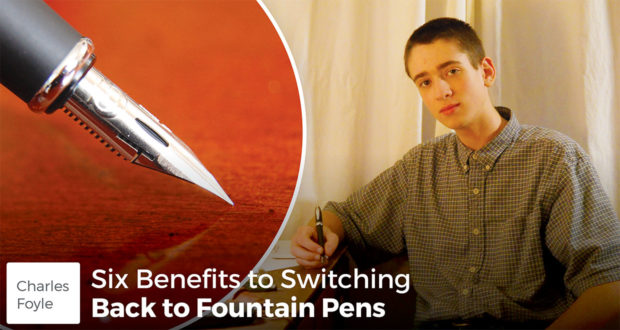Summary
With six advantages for homeschooling students and parents, Charles Foyle writes an eloquent case of why fountain pens still rule in the 21st century.Back and better than ever, modern fountain pens are easy to use and loaded with advantages for homeschooling students and parents.
They’re great for cursive, they are more comfortable to use, and they don’t pile up like logjams on the desk.
A good fountain pen will last longer than you will. Many reliable ones are available for a modest price, and, if your favorite pen breaks down, you can usually fix it easily.
I have used fountain pens for two years and believe, for many homeschoolers and their parents, that these redoubtable old tools might be the answer to the latest writing needs.
Cursive.
The primary advantage to fountain pens is cursive, the penmanship style for which they are best suited. A fountain pen doesn’t write from the end of the nib, but from the bottom. The nib, the split metal point that contacts the paper, rests on an iridium ball welded to its end.
Using capillary action, the slit draws ink from the reservoir, or fountain, to the paper. This means that, for cursive, there is no pushing down to get a ball turning or rub off graphite. To create flowing lines, you need a good pen that can handle them.
Hence, if you struggle with writing cursive, a fountain pen might be the right choice for you.
Comfort.
Nobody wants you to make writing harder than necessary. Many people who use regular pens death-grip the handle as they write. Knuckles whitening, they print vigorously for a few lines, lay the pen down, wring their hand, and start typing. This brings us to the next advantage of the fountain pen.
A good fountain pen cures over-gripping and can make cursive as easy as or easier than printing. The fountain pen should not be clenched upon, but allowed to rest in your hand. Often the tip of the nib is smaller than the end of a ballpoint, reducing friction by presenting less surface area to the paper. The ink further reduces friction due to its slickness. Best of all, fountain pens work best at a natural angle, unlike ballpoints.
With a good, smooth pen and proper grip, you can fill out a page of neat cursive in a matter of minutes.
Clutter.
Somehow I remember Seton Magazine articles talking about harried homeschool moms having to store bags of pens, or start keeping pen cups, and other articles talking about decluttering as a potent source of order. The question is, most people only can write with one pen at a time, so why keep big jars full of pens that dry up and go bad before they are used up? Again, the fountain pen returns as a decluttering machine. With appropriate inks, a fountain pen can even take the place of a highlighter.
Longevity.
The fountain pen was developed in 1879, and some lucky collectors have pens from the 1880s and ‘90s that still write. If well-kept, a fountain pen develops no trouble. Modern nibs, made of stainless steel or gold with a welded iridium tip, are almost impossible to wear out. Ink cleans out of a good pen easily, with a quick flush in either tap or distilled water or a diluted solution of ammonia. If I don’t wear them out first, my pens might outlast me.
Value.
Mont Blanc, Visconti, and Pelikan all make some mighty fine pens. However, you don’t have to buy a fancy one to write well. My Noodler’s Ahab only cost twenty-three dollars, and it writes perfectly with either a fine-medium, or a steel “flex” nib that allows it, with a bit of extra pressure, to create thick or thin lines.
Bottled ink by companies like Diamine and Noodler’s is safe for vintage to modern pens, and is cheap compared to a pack of quickly-drained cartridges or ballpoint refills. Many good pens are available for less than fifty dollars, and there are some fine ones for less that twenty-five. I even have one Noodler’s model that was a promotional sold with ink. It is heavy-duty and leak-resistant, and its performance is flawless.
Repair.
Fountain pens aren’t impossible to fix. For common models, parts are fairly cheap and often interchangeable. My personal pen began leaking severely a month ago from the feed. I cleaned it out and, using very hot water, heated up its business end. A bit of pressure on the hard rubber “feed,” which transfers ink from fountain to nib slit, welded it to the bottom of the nib. Results? Perfect writing without the first dribble.
By and large, fountain pens hold many potential benefits for the homeschooler.
Once initial fears of a new pen becoming a leaking mess are overcome, they are actually a reliable tool that will make cursive easier, last for decades, and cut down on the accumulating heaps of disposable pens.
They work fine for me, and you might want to try them as well.

 Seton Magazine Catholic Homeschool Articles, Advice & Resources
Seton Magazine Catholic Homeschool Articles, Advice & Resources
